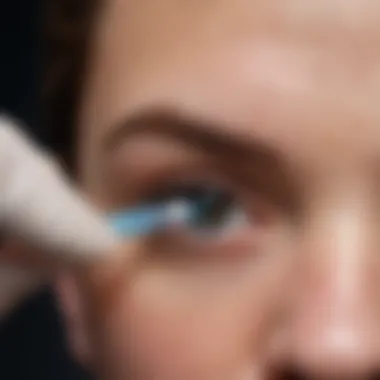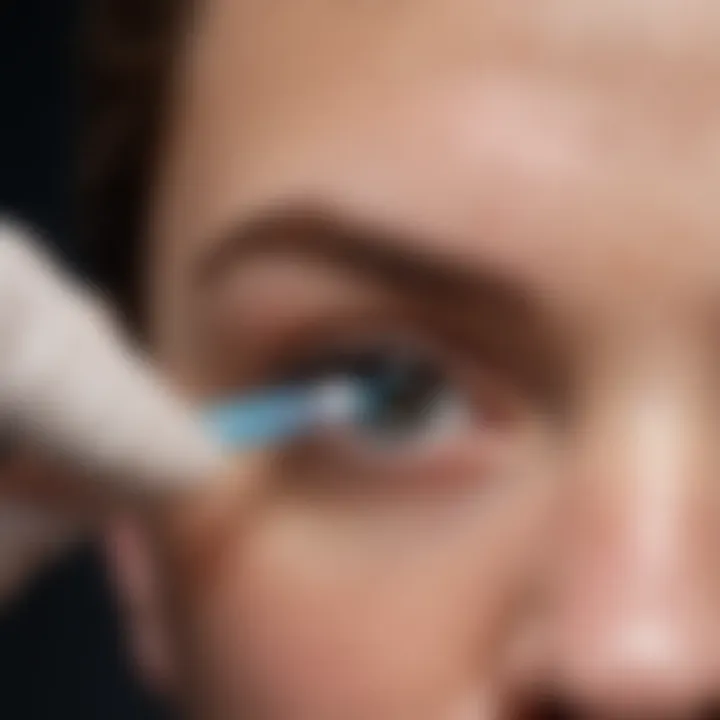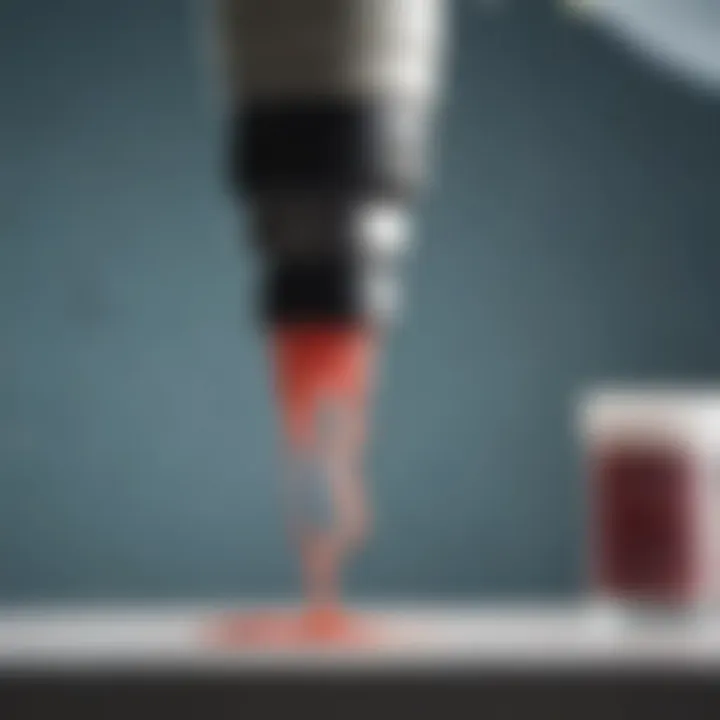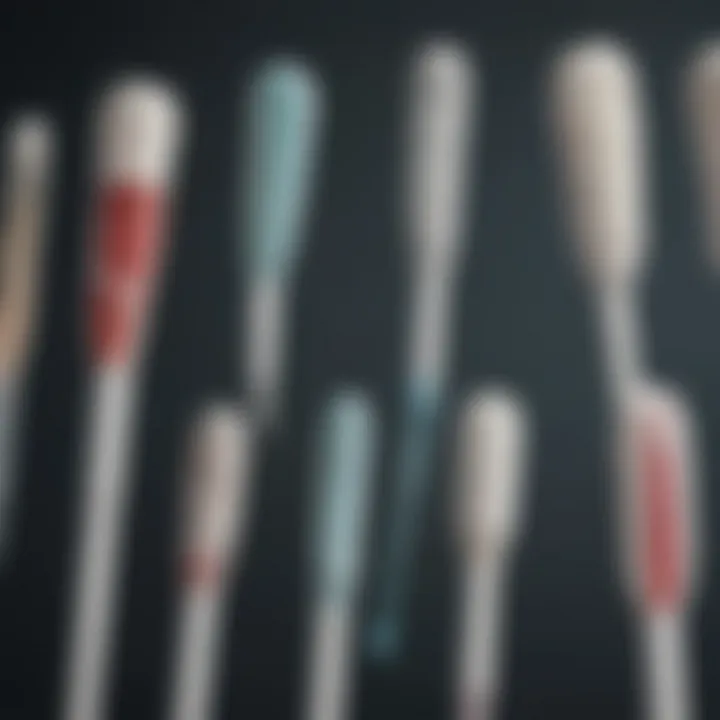Wound Swabbing: Techniques and Patient Impact


Intro
Wound swabbing plays a crucial role in the field of medicine, specifically in assessing and treating infections related to wounds. It involves the use of specific swabbing techniques to collect samples from wounds, allowing healthcare professionals to evaluate the presence of pathogens that may impede healing. The reliability of these samples is vital for determining the appropriate course of treatment.
In this article, we will explore various compelling facets of wound swabbing, including methodologies, types of swabs, and their implications on patient outcomes. Detangling these elements will help healthcare professionals better navigate the complexities of wound management, ultimately leading to improved patient care.
Research Overview
Summary of Key Findings
Research indicates that wound swabbing significantly enhances the accuracy of infection diagnosis. Studies show that the choice of swab materials, such as nylon or calcium alginate, influences the yield of pathogens. Furthermore, the timing of swabbing in relation to wound care can alter results. For instance, swabbing prior to the application of antiseptics generally provides clearer insights into the infection.
Importance of the Research
Understanding the dynamics of wound swabbing is imperative for health care practitioners. As infection rates can severely impact patient recovery, effective sampling becomes an invaluable tool for ensuring proper care. The implications are vast, with research underscoring a strong correlation between sample accuracy and successful treatment outcomes.
Methodology
Study Design
Most studies on wound swabbing adopt a prospective design, allowing researchers to observe outcomes in real-time. Randomized controlled trials are common, enabling a robust evaluation of different swab types and techniques. This structured approach adds credibility to findings about best practices in wound assessment and management.
Data Collection Techniques
Data collection in studies of wound swabbing often involves clinical assessments, laboratory analyses, and patient surveys. Following swabbing, samples are sent to laboratories for microbial culture and sensitivity testing. Clinicians often gather additional data regarding patient demographics, wound characteristics, and treatment responses, providing a holistic perspective on the impact of swabbing practices.
Effective wound swabbing not only identifies the presence of pathogens but also shapes the subsequent treatment approach, thereby playing a key role in patient outcomes.
Monitoring these outcomes fosters an environment of continuous improvement in clinical practices, ultimately benefiting patient care and recovery.
Preamble to Wound Swabbing
Wound swabbing is a critical element in modern medical practice, central to the assessment of infections and guiding effective treatments. In this article, we explore the various dimensions of wound swabbing, including techniques, applications, and impacts on patient care.
Understanding wound swabbing is essential for healthcare professionals, particularly those involved in wound management. Effective swabbing can significantly influence treatment outcomes. Accurate sampling identifies the pathogens present in a wound, which informs the choice of antibiotics and treatment strategies.
In addition, wound swabbing relates closely to infection control protocols. Each step in the swabbing process has implications for patient safety and recovery. Thus, understanding the various methodologies is vital.
Definition of Wound Swabbing
Wound swabbing refers to the method of collecting samples from a wound to identify the presence of pathogens. This may include bacteria, fungi, or viruses. The process typically involves using a sterile swab to gently collect a sample from the wound surface. It is a straightforward procedure but requires training to ensure that it is done correctly and effectively.
The swab collects material that can be sent to a laboratory for analysis, helping clinicians determine the precise nature of any infection. This is crucial for devising appropriate treatment plans, preventing further complications, and promoting healing.
Historical Context
Wound care and swabbing have evolved significantly over the years. The origins of wound management date back to ancient civilizations, where rudimentary methods were employed to treat injuries. In the late 19th century, advances in microbiology led to a better understanding of infections and their causes.
With the discovery of antiseptic techniques, medical professionals gained new tools to manage wounds effectively. The introduction of swabbing allowed for more precise diagnosis and targeted therapies. Prior to this, untreated infections often led to complications and poor patient outcomes.
As the field of medicine continues to advance, the techniques surrounding wound swabbing have also progressed. Now, more sophisticated tools and methods are available. Understanding this historical context allows clinicians to appreciate the importance of proper swabbing techniques today.
The Importance of Wound Swabbing in Clinical Medicine
Wound swabbing plays a significant role in the realm of clinical medicine. It is an essential procedure in assessing and managing wound infections. When performed correctly, it provides healthcare professionals with critical insights into the presence of pathogens within a wound. This perspective is vital for tailoring appropriate treatment protocols. Moreover, accurate sampling can impact patient health outcomes positively. Therefore, a nuanced understanding of wound swabbing's importance can enhance clinical practices.
Role in Infection Detection
Wound infections can lead to severe complications if not identified early. Wound swabbing serves as a primary method for detecting these infections. The process involves using a sterile swab to collect sample material from the wound surface. This sample can harbor bacteria, fungi, or other microorganisms, which are then analyzed in the laboratory.
The vital benefit of swabbing is that it helps in identifying infecting organisms. Different bacteria have different treatment requirements. For instance, a sample showing the presence of Staphylococcus aureus means that specific antibiotics need to be administered. A rapid diagnosis can significantly affect how swiftly a healthcare provider can respond to an infection. In this context, wound swabbing is not just a routine task; it is a key intervention in preventing further complications.


Guiding Treatment Decisions
The results obtained from wound swabbing significantly guide treatment decisions. Once the causative agents of an infection are identified, clinicians can select appropriate antibiotics or other treatment strategies. This targeted approach minimizes the risk of antibiotic resistance, which is a growing concern in modern medicine. Furthermore, swab results can guide surgical interventions if necessary, such as debridement or closure techniques.
In addition to guiding these choices, swab analysis contributes to monitoring treatment efficacy. After initiating treatment based on initial swabbing results, follow-up samples can assess whether the infection is resolving. If the same pathogens persist, it may signal the need for alternative therapies or further specialist input.
Methods and Techniques of Wound Swabbing
Wound swabbing is an essential component of modern wound management. The methods and techniques employed in this process directly influence the accuracy and efficacy of infection detection. By utilizing proper swabbing methods, healthcare professionals can ensure high-quality samples that guide treatment decisions. This section looks closely at the particular techniques used in wound swabbing, their significance, and the considerations that must be accounted for.
Manual Swabbing Techniques
Manual swabbing is a traditional method where healthcare providers use sterile swabs to collect samples from the wound. This technique requires a specific approach to ensure contamination is minimized. First, the healthcare worker must wash their hands and wear appropriate personal protective equipment. After eyeing the wound, they need to select a sterile swab, which is then moistened if necessary.
Once the swab is ready, it should be gently rotated in the wound bed. Care should taken to sample the wound margins and areas with visible exudate. This technique allows for a diverse range of pathogens to be captured. One key benefit of manual swabbing lies in its cost-effectiveness. It requires basic equipment and can be performed in various clinical settings. However, the effectiveness largely depends on the skill of the practitioner.
Automated Swabbing Devices
The evolution of technology has led to the introduction of automated swabbing devices. These devices aim to enhance the efficiency and reliability of wound sample collection. Automated devices often feature a built-in mechanism to ensure consistent pressure and movement during swabbing. The technology not only minimizes the risk of contamination but also improves repeatability in sample collection.
One significant advantage of using automated devices is their ability to standardize the process, ensuring that all samples are collected uniformly. These devices can be programmed to adhere to specific parameters set by healthcare protocols. However, the initial investment in such technology may be a barrier for some healthcare facilities, especially in resource-limited settings.
Standard Operating Procedures
Developing standard operating procedures (SOPs) for wound swabbing is critical for ensuring consistency and quality in the sampling process. SOPs should outline each step of the swabbing process, from preparation to collection to analysis. Clear instructions create a framework that guides healthcare professionals, enhancing the quality of samples collected.
Among the considerations in creating SOPs are:
- Training for Staff: Staff should receive training to understand the proper techniques and the importance of following protocols.
- Equipment Preparation: Instructions on how to prepare the necessary equipment should be included.
- Documentation: Clear guidelines for documenting the collection process are vital. This ensures traceability and accountability in patient care.
Adopting these SOPs not only improves the overall quality of wound management but also fosters an environment where continuous improvement can take place.
Implementing standardized practices in wound swabbing is vital for achieving reliable and reproducible results.
Types of Swabs Used in Wound Sampling
The use of appropriate swabs in wound sampling is crucial. The effectiveness of wound swabbing largely depends on the type of swab used. Selecting the right swab can influence the accuracy of infection detection and consequently, the treatment regimen. This section addresses key factors regarding the swabs utilized in wound sampling, focusing on material composition and considerations of shape and size.
Material Composition of Swabs
Swabs are made from various materials, each impacting their performance in wound sampling. Common materials include:
- Cotton: Often used due to its ability to absorb fluids. However, natural fiber can harbor bacteria, making it less ideal for sterile conditions.
- Rayon: This synthetic fiber is highly absorbent and is preferable when collecting microbiological samples. It does not shed lint, reducing contamination risks.
- Polyester: Known for its durability and resistance to chemicals. Used significantly in molecular diagnostics.
- Foam: Offers excellent fluid retention and is gentle on wound surfaces, making it suitable for sensitive tissues.
The choice of material affects the transfer of microbes during sampling. The absorbency and potential for contamination must be carefully considered when choosing swabs for specific scenarios.
Swab Shape and Size Considerations
The shape and size of swabs significantly influence sampling efficiency. Factors include:
- Swab Size: Larger swabs generally collect more sample material. Yet, they may be too bulky for deep or narrow wounds. Smaller swabs allow for targeted sampling but can miss broader infection areas.
- Swab Shape: Some swabs feature a rounded tip, which can be effective in collecting samples from irregularly shaped wounds. Others may have a flat surface, which may enhance sample collection from larger, flat areas.
- Handle Length: Longer handles provide accessibility to deeper wounds. Short-handled swabs may be easier to manipulate in shallow areas.
Selecting the right swab shape and size must take into account the wound location, depth, and type of tissue. The decision directly impacts the swab's ability to collect a representative sample, which is essential for accurate analysis.
It is essential to match the swab's characteristics to the specific wound environment to maximize sample integrity.
Analyzing Swab Samples
Analyzing swab samples is a crucial step in the process of wound management. The analysis of these samples serves not only to identify pathogens but also helps in tailoring appropriate treatment plans based on the types of bacteria or fungi present. Accurate analysis is essential for managing infections effectively. The two primary methods utilized for analyzing these samples include microbiological culturing techniques and molecular methods for pathogen identification.
Microbiological Culturing Techniques


Microbiological culturing techniques are traditional methods used to grow microorganisms from the swab samples taken from wounds. These techniques involve inoculating specific media with the sample and incubating it under controlled conditions. Once growth is observed, identification of the pathogens can occur through various biochemical tests or microscopy.
The main benefits of microbiological culturing techniques include:
- Broad-spectrum identification: Culturing allows for the detection of a wide range of bacteria, both aerobic and anaerobic.
- Antibiotic sensitivity testing: This method enables healthcare providers to determine the resistance or susceptibility of pathogens to specific antibiotics, guiding effective treatment choices.
- Long-term data collection: By storing and analyzing cultures, trends in bacterial infections over time can be monitored, aiding in understanding local epidemiology.
However, culturing does have limitations. It can take several days to yield results, which may delay critical treatment decisions. Furthermore, some fastidious organisms might not grow in standard culture media, possibly leading to false negatives.
Molecular Methods for Pathogen Identification
Molecular methods for pathogen identification represent a modern approach that offers speed and specificity. Techniques such as polymerase chain reaction (PCR) allow for the direct detection of microbial DNA from swab samples. This method has several advantages:
- Rapid results: Molecular techniques can provide near-instantaneous results, allowing for quick decision-making in patient care.
- High sensitivity and specificity: These methods can detect low quantities of pathogens and are less prone to contamination, improving accuracy in identifying the infectious agents.
- Identification of difficult pathogens: Molecular methods can detect microorganisms that traditional cultures might miss, such as certain viruses or fungi.
Nevertheless, molecular techniques require specialized equipment and trained personnel, which may limit their availability in some clinical settings. Additionally, costs associated with these methods can be prohibitive, particularly for smaller clinics.
Factors Influencing Wound Swab Quality
Wound swabbing quality is essential for accurate diagnosis and treatment of infections. Various elements influence this quality, including timing and sterility. Understanding these factors helps healthcare professionals to optimize swabbing procedures, leading to better patient outcomes.
Timing of Sample Collection
The timing of sample collection is crucial in wound swabbing. Collecting samples at the right moment ensures accurate representation of the microbial environment of the wound. For instance, swabbing after the administration of antibiotics may not provide an accurate picture of the infection. Careful consideration of when to perform the swab can provide critical data that informs diagnosis and subsequent treatment decisions.
It is advisable to collect samples during initial patient assessment, prior to starting antibiotics. Delaying swabbing until the wound has had a chance to stabilize may also yield more reliable results. Regularly scheduled swabbing can track changes in wound flora over time.
- Proper timing helps in identifying infection when it is most evident.
- It also prevents misinterpretation of results caused by treatment effects.
Sterility and Contamination Issues
Maintaining sterility is paramount in obtaining high-quality wound swabs. Contamination can lead to misleading results, which may affect treatment choices. Ensuring that swabs are collected using sterile techniques minimizes the risk of external bacterial interference.
Here are several key points to consider:
- Use of sterile swabs: Only sterile swabs should be used to collect samples. This prevents foreign bacteria from impacting the results.
- Proper technique: The technique used to perform the swab can influence sterility. Staff must be trained to follow established protocols.
- Environmental factors: The space where swabbing occurs should be clean and, if possible, free from other sources of contamination.
Achieving sterility in wound swabbing not only boosts the reliability of clinical results but also enhances overall wound management.
Accurate wound swab quality is integral to infection management and influences how effectively healthcare providers can respond to patient needs.
Challenges in Wound Swabbing
Wound swabbing plays a crucial role in diagnostic processes, yet it is fraught with challenges that can significantly impact the results obtained. These challenges stem from multiple factors, including technical issues, human error, and the complexity of the wound environment itself. Understanding these challenges is vital for healthcare professionals as they influence infection management and treatment outcomes.
Interpreting Swab Results
Interpreting the results of wound swabbing is not straightfoward. The presence of microorganisms does not always indicate an active infection. Therefore, contexting the microbial findings within the patient’s clinical presentation is critical. An accurate assessment requires familiarity with normal skin flora, as well as potential pathogenic organisms.
False positives can lead to unnecessary treatments, while false negatives may result in missed infections. Performing a comprehensive review of the patient's history, symptoms, and the type of wound is essential for correct interpretation. Furthermore, the laboratory methods used for analyzing samples can also vary in sensitivity and specificity.
"Accurate interpretation of swab results is integral to effective wound management."
Healthcare professionals should prioritize collaboration with microbiologists and use standardized protocols to enhance the reliability of results. This collaborative approach facilitates better understanding and planning for patient care.
Management of Non-viable Samples
Non-viable samples present another significant challenge in wound swabbing. A sample is considered non-viable if it cannot provide useful information about the wound's condition or if it yields no growth during culture. This situation may arise from several factors such as improper collection techniques, delays in processing, or inadequate transport conditions.
Managing non-viable samples involves several steps. First, it is important to analyze the reasons behind the sample's viability. Training and adherence to correct sampling techniques are crucial to minimize issues. Adequate labeling and prompt laboratory processing can also contribute significantly to sample quality.
If a non-viable sample is identified, immediate resampling may be necessary. This new sample should be collected under improved conditions, ensuring that healthcare staff follow sterilization protocols meticulously to avoid contamination. Addressing these factors not only boosts the quality of the swab results but also enhances patient safety.


In summary, challenges in wound swabbing encompass both interpreting results and managing sample viability. Addressing these challenges requires an emphasis on proper education and protocols, ensuring that healthcare providers can reliably assess and treat wound infections.
Emerging Technologies in Wound Swabbing
Emerging technologies are reshaping the field of wound swabbing, enhancing the efficiency and accuracy of infection detection. The integration of advanced techniques not only aids in the identification of pathogens but can also streamline the workflows in clinical settings. As the healthcare sector adapts to rapid technological advancements, it is crucial to understand the specifics of these emerging methods.
Nanotechnology Applications
Nanotechnology offers significant potential in wound swabbing, particularly through the development of nanosensors. These devices can detect microorganisms at extremely low concentrations. Nanosensors utilize nanoparticles to interact with specific pathogens, leading to detectable signals that indicate the presence of bacterial infections. The sensitivity of these sensors can surpass conventional methods, allowing for earlier diagnosis of infections.
Some key benefits of nanotechnology in wound swabbing include:
- Enhanced Sensitivity: Nanosensors can identify pathogens that traditional swabbing might miss.
- Rapid Results: The technology can reduce the turnaround time for results, enabling quicker treatment decisions.
- Minimally Invasive: Many nanotechnology-based swabbing techniques require smaller samples, reducing discomfort for patients.
However, the integration of nanotechnology in routine practice faces challenges. Regulatory hurdles and validation of these technologies are ongoing. Ensuring that these methods are safe and effective in diverse patient populations is an essential step for broader adoption.
AI and Machine Learning in Sample Analysis
Artificial Intelligence (AI) and machine learning are transforming how swab samples are analyzed. These technologies can streamline the interpretation of complex data generated from swab cultures. By training algorithms on large datasets, AI can help in classifying pathogens more accurately and rapidly than traditional analysis methods.
Benefits include:
- Improved Accuracy: Machine learning models can learn from previous cases, leading to better diagnostic precision over time.
- Automation of Analysis: AI can automate aspects of data analysis, freeing up clinical staff to focus on patient care rather than data interpretation.
- Predictive Analytics: Advanced algorithms can predict outcomes based on historical data from swab samples, aiding clinicians in making informed decisions.
Despite the promise of AI, there are important considerations. The algorithms are only as good as the data they are trained on. Ensuring data quality and addressing biases in training datasets is critical for reliable outcomes. Additionally, integration into existing healthcare systems can be challenging and requires thoughtful implementation strategies.
The application of emerging technologies like nanotechnology and AI offers exciting prospects for the future of wound swabbing, potentially improving patient outcomes through enhanced diagnostics and treatment options.
Future Directions in Wound Swabbing Research
Future directions in wound swabbing research are essential to optimize methodologies and improve clinical outcomes. As the landscape of healthcare evolves, these directions will likely influence how healthcare professionals assess and treat wounds. Innovating in this area holds great promise for enhancing patient care through better techniques and deeper data integration.
Integration with Electronic Health Records
The incorporation of wound swabbing data into Electronic Health Records (EHR) offers significant benefits. This integration can facilitate the real-time sharing of patient information across various healthcare settings. For instance, when clinicians have immediate access to swab results via EHR, they can make faster decisions regarding treatment plans.
Moreover, integrating swabbing data allows for comprehensive tracking of infection trends. By analyzing historical data, healthcare providers can identify patterns that reinforce preventative measures, leading to a more proactive approach to wound care. The automated data entry into EHR reduces human error and improves the consistency of information. This level of organization is crucial for ensuring that every patient's treatment is optimized according to their unique medical history and needs.
Some points to consider regarding EHR integration include:
- Standardization of Data: Consistency in entering swab results can enhance interoperability.
- Patient Engagement: EHRs can improve communication with patients by keeping them informed about their treatment progress.
- Research Opportunities: Aggregated data can provide substantial insights for larger studies focused on wound healing and management.
Improving Patient Outcomes Through Enhanced Techniques
Advancements in wound swabbing techniques stand to greatly improve patient outcomes. Enhanced methods, for instance, can yield more accurate and reliable results that guide treatment options. Improved sampling techniques, such as using more sophisticated swab materials or better-conditioned environments for swabbing, can reduce the likelihood of contamination.
Research into minimally invasive techniques to assess wounds also offers promise. For instance, the utilization of biosensors or portable diagnostic platforms can minimize the discomfort and risk associated with traditional swabbing methods. Furthermore, continuing advancements in molecular techniques enhance the ability to rapidly identify pathogens, which is critical in administering timely and effective treatment.
Key aspects to note about improving techniques include:
- Innovation in Materials: New swab materials may offer enhanced sensitivity to pathogens.
- Training and Protocols: Ongoing training for healthcare professionals about best practices in swabbing can ensure high-quality samples.
- Patient-Centric Approaches: Emphasizing techniques that consider patient comfort directly correlates with improvement in overall care.
"Investing in advanced research for wound swabbing techniques can catalyze pivotal changes in patient healing processes, reducing hospital stays and resource usage."
The End
The conclusion section serves a vital role in encapsulating the entire discussion of the article. It provides an essential recap of significant topics related to wound swabbing, allowing the reader to reflect on its importance in clinical settings. The conclusion reinforces how wound swabbing is not just a mere procedural step but a critical component in ensuring patient care and effective treatment planning.
Summary of Key Points
In this article, we have examined several fundamental aspects of wound swabbing:
- Definition and Historical Context: Understanding the evolution of wound swabbing highlights its relevance in today's medical practice.
- Clinical Importance: The role of wound swabbing in infection detection and guiding treatment decisions is crucial for patient management.
- Methods and Techniques: Various techniques, both manual and automated, were discussed alongside standard operating protocols that ensure effective sampling.
- Types of Swabs: The discussion on material composition and the implications of suitable swab shape and size is highlighted.
- Sample Analysis: Microbiological culturing techniques and molecular methods showcase the technological advancements in pathogen identification.
- Factors Impacting Quality: Timing and sterility are key factors that can affect the integrity of sample outcomes.
- Challenges: Interpreting results and managing non-viable samples add complexity to the process of wound swabbing.
- Emerging Technologies: The potential of nanotechnology and AI in enhancing wound swabbing techniques.
- Future Directions: Integration with electronic health records and improving patient outcomes remain forefront in future research efforts.
Final Thoughts on Wound Swabbing
Wound swabbing is an integral part of contemporary healthcare that addresses critical facets of infection management. As techniques and technologies evolve, their impact on improving patient outcomes becomes increasingly apparent. It is essential for healthcare professionals to stay informed about the latest advancements and methodologies in wound swabbing. Doing so not only contributes to more accurate diagnoses but also enhances treatment protocols, thus improving overall patient healthcare experiences.



